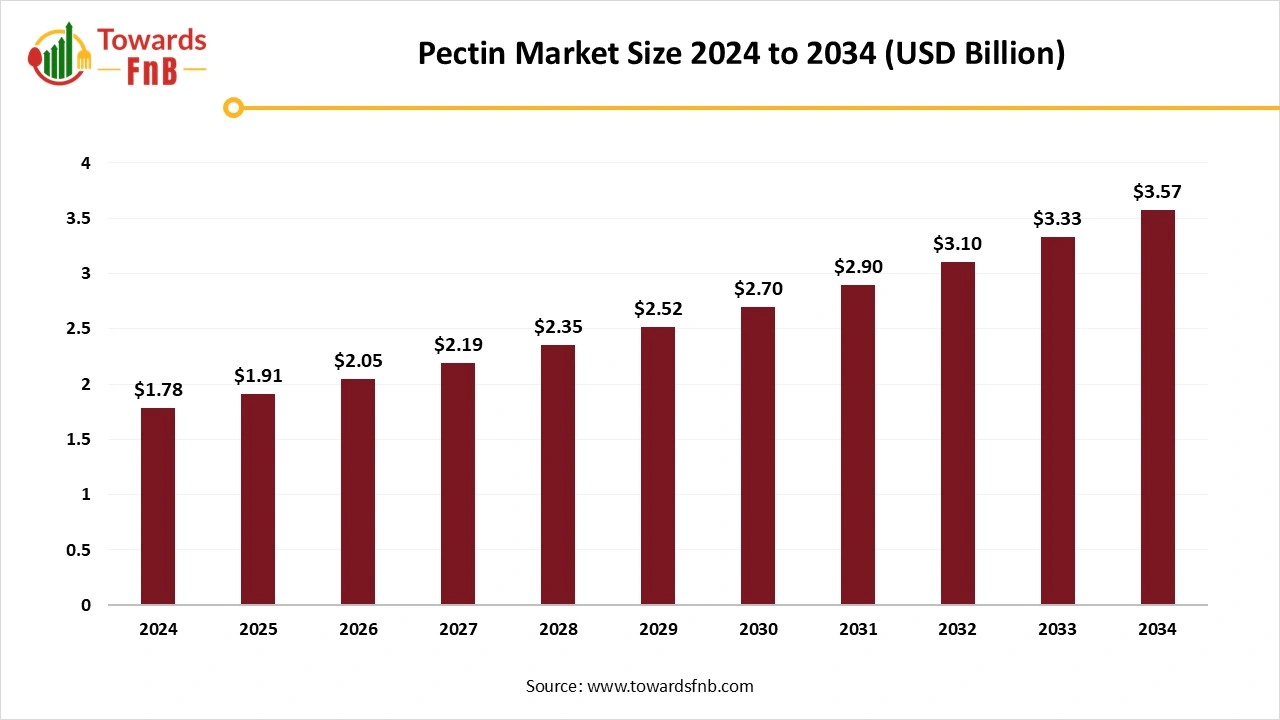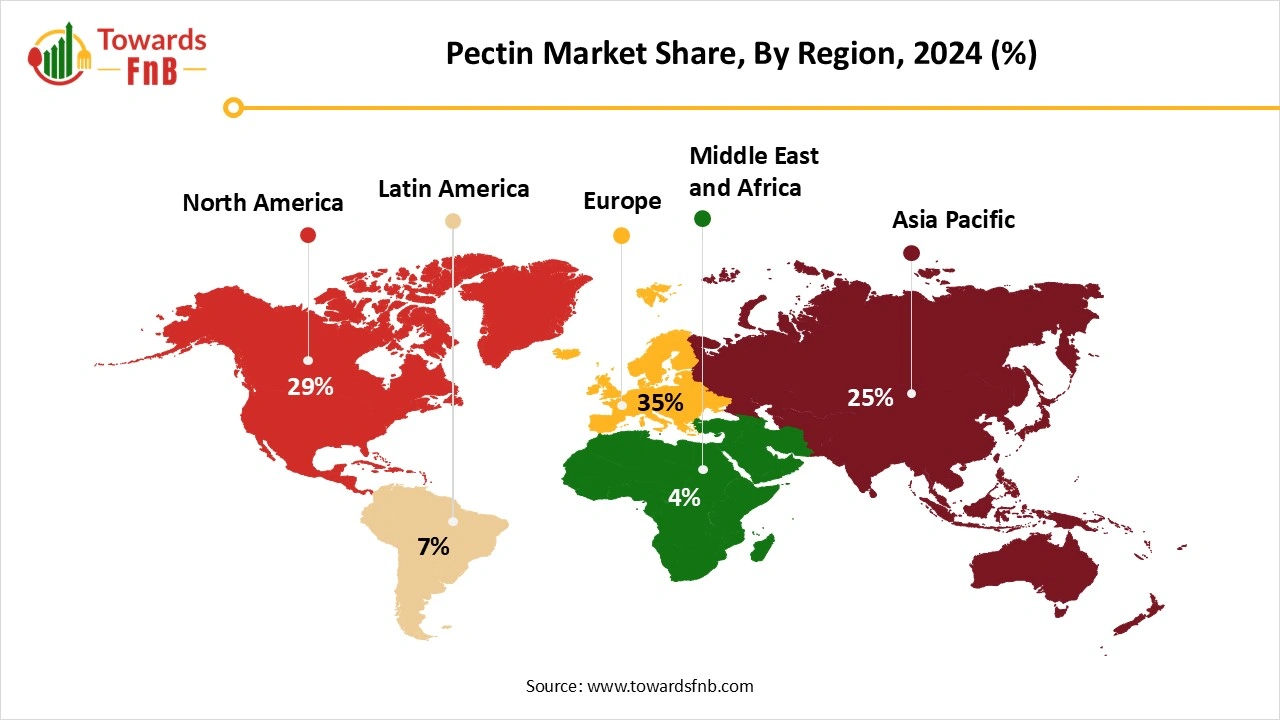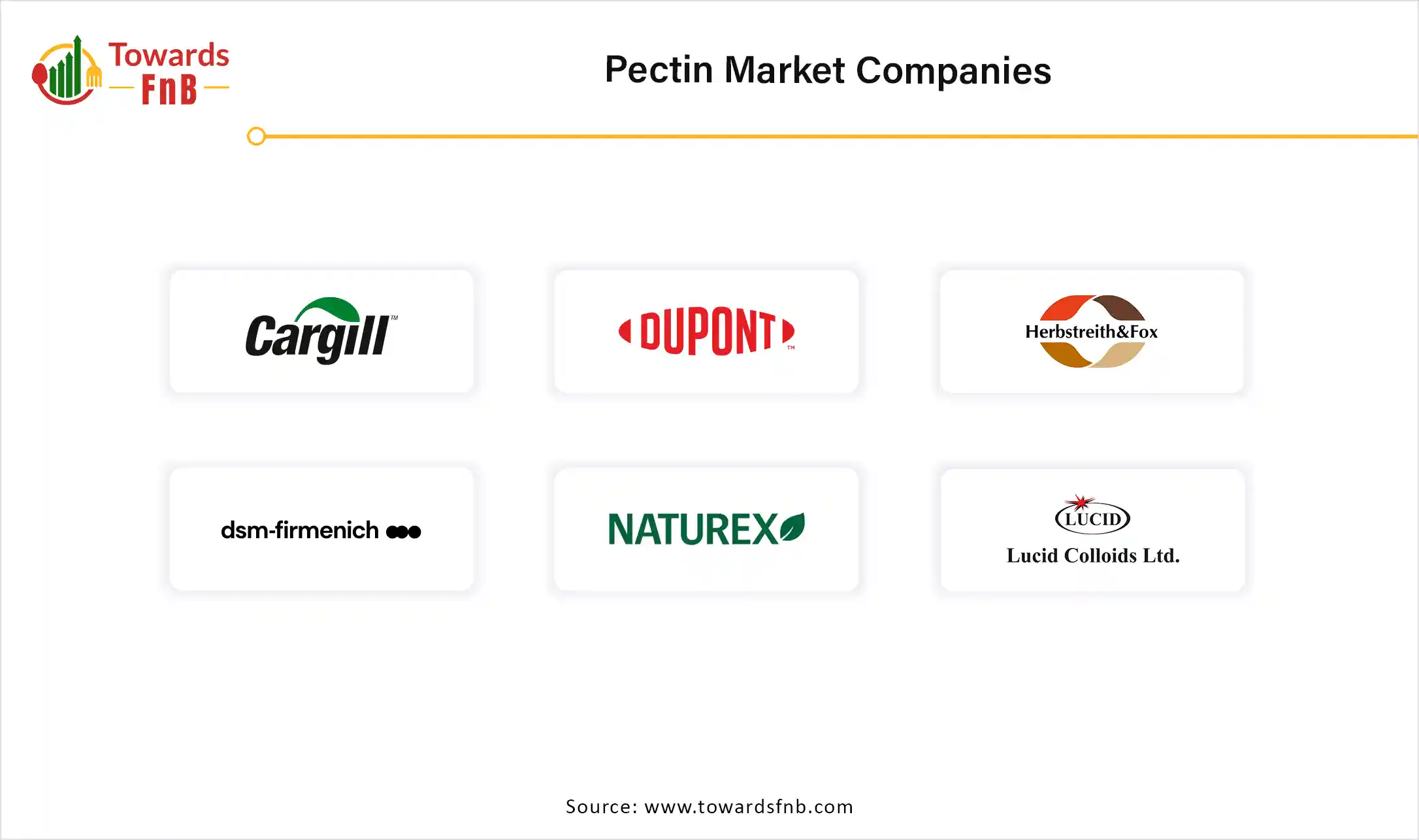November 2025
The global pectin market size calculated at USD 1.78 billion in 2024 and is anticipated to increase from USD 1.91 billion in 2025 to an estimated USD 3.57 billion by 2034, witnessing a CAGR of 7.2% during the forecast period from 2025 to 2034. The market is significantly proliferating due to pectin finding extensive applications in various sectors like food/beverages, cosmetic, pharmaceutical, and homemade food products. Increasing waves of clean-label products along with increased health consciousness across the world.

| Study Coverage | Details |
| Growth Rate from 2025 to 2034 | CAGR of 7.2% |
| Market Size in 2025 | USD 1.91 Billion |
| Market Size in 2026 | USD 2.05 Billion |
| Market Size by 2034 | USD 3.57 Billion |
| Largest Market | Europe |
| Base Year | 2024 |
| Forecast Period | 2025 to 2034 |
| Regions Covered | North America, Europe, Asia-Pacific, Latin America, and Middle East & Africa |
Pectin is a complex polysaccharide primarily derived from plant cell walls (mainly citrus fruits and apples) and is used widely as a gelling agent, thickener, stabilizer, and emulsifier in food and beverages. Due to its functional properties and clean-label appeal, pectin also finds applications in pharmaceuticals, personal care, and industrial sectors. Pectin is popularly known for its solubility nature and act as a thickening agent to offer desire viscosity for fluid products from pharmaceuticals and food/beverage sector.
Consumers are becoming highly aware about proactive health care approach and looking for natural, clean label ingredients to gain maximum benefits. Pectin perfectly fit in this changing pattern of market by providing overall well-being, eco-friendly alternative and supports growing clean-label movement by many consumers across the globe. as pectin is derived from fruit’s outer layer, it perfectly aligns with the changing consumers demand and comply even with stringent safety regulations set by authorities, further propelling the pectin market’s growth on a global platform with a significant scale to be recognize.
A significant and transformative opportunity that pectin market is witnessing is increasing trend for plant-based and vegan food/beverages products by many consumers instead of meat and nonveg food products to gain maximum and high-quality micronutrients and protein on a regular basis. Plant-based pectin is derived from various plants, herbs and fruits like citrus category fruits and apples which shows an eco-friendly approach to produce pectin and does not harm animals for food production. This trend is growing due to animal welfare awareness and growing research shows how a vegan diet positively influences gut bacteria and overall well-being.
A notable challenge that the pectin market is witnessing is the growing development of microbial pectin analogues, creating a significant challenge for the market’s expansion. As pectin is majorly derived from fruits and plants, the method of pectin extraction is widely accepted. However, the emergence of pectin production through biotechnology convergence presents a possibly more sustainable and cost-effective alternative for plant-based pectin production. This new development may disrupt the supply chain of plant-based pectin, which needs to be balanced by some regulations.
How are Leading Marketers Backed by Government Transforming Europe Pectin Market?
Europe dominated the global pectine market with a share of 35% in 2024. The region's growth is primarily driven by factors like increasing consumers demand for clean-label products, highly established food and beverage industry in the Europe and strict safety regulations in Europe that encourages manufacturers to adopt ethically sourced ingredients in various sectors like cosmetics, pharmaceuticals and food/beverages. Further, Europe has highly focused areas on research and development for food and pharma industry which offers continuous innovations like various methods to extract pectin such as conventional acid extraction. It is a majorly used method due to its high scalability and relatively low cost of processing.
Moreover, leading countries like Italy, UK, France, Germany, Russia are leading contributors of Europe pectin market. Among these, France is a leading innovator with 30+ patent acquired on pectin usage in cosmetic industry. While small-scale producers of pectin in Italy controls 45% of regional supply chain. A leading marketer in Europe, CP Kelco, increased its apple pectin production capacity by 15% in 2024 to fulfill increasing demand from the pharmaceutical and nutraceutical industries. In addition to this, European government has approved a 20-euro million grant to develop sustainable pectin extraction technologies in 2023 which is impacting positively in the research and development area of Spain and Italy.

What are the Major Shifts Fueling Asia Pacific Pectin Market?
Asia Pacific is expected to grow at the fastest CAGR during the foreseeable period of 2025-2034. The region is significantly growing due to increasing trend for clean-label products, plant-based food products and diets, government initiatives for circular economy to protect environment from hazardous industrial wastes, expanding industries like cosmetics, drug delivery systems and fueling production of pectin on a local level of Asian countries. Pectin offers moisturization and stabilizing properties, which are the base of cosmetics and personal care brands. Also, it is an eco-friendly and ethically sourced complex carbohydrate that is considered a clean ingredient.
Moreover, increasing urbanization rate is directly impacting the source of disposable incomes in Asia Pacific countries like India, Japan, Korea and China where, expansion of food and beverage sector is leading a demand for processed food and functional foods/additives owing to growing awareness of healthy lifestyle among many consumers. Such major shifts in the region are responsible for fueling the growth of pectin production and, in turn, pectin market in Asia pacific.
Which Key Factor Drives Citrus Derived Pectin in the Pectin market?
The citrus peel segment dominated the global pectine market in 2024. The segment is dominating due to factors like high level pectin content in citrus, its various applications, increasing clean label trend across the globe, and well-established supply chain infrastructure. Among these, high level pectin content in citrus fruits is a key driver of the segment's growth. Consumers shift towards naturally derived substances and high methoxyl pectin. Consumers are opting for pectin content products which are majorly driven by health benefits related to pectin like improved digestion and heart health. Within this citrus category, orange-derived pectin is highly used due to its texture-enhancing and gelling characteristics, contributing to the higher demand for pectin.
The sunflower segment is expected to grow at the fastest CAGR during the foreseeable period of 2025 to 2034. The segment is expanding due to various applications of sunflower derived pectin and increasing veganism and plant-based diets across the world. Sunflower pectin acts as a gelling, thickening and stabilizing agent which is highly applicable in the food and beverage sector.
What Properties Make High Methoxyl Pectin, a Highly Appealing Pectin Type in the Pectin Market Globally?
The high methoxyl segment dominated the global pectine market in 2024. The segment dominates due to advancement in extraction and formulation methods for pectin, which leads to higher pectin production with a high level of methoxyl. Methoxyl is majorly used for its excellent gelling properties, which offers thickening, and viscosity as needed. It could form strong gels by combining sugar and acid, making it a highly suitable option for jams, jellies, and fruit preservatives. High methoxyl type pectin finds extensive applications like bakery fillings, confectionery, and different types of bakery products. Considering its major applications, technologies and various methods have been developed by researchers to extract high quality pectin, which is a key driver of the segment.
The amidated low methoxyl pectin segment is expected to grow at the fastest CAGR during the foreseeable period of 2025 to 2034. The segment is expanding due to low methoxyl pectin, which is highly applicable for reducing sugar and calorie content in a product. It is calcium efficient and can be used in various food products like dairy, bakery, and beverages.
Which are the Benefits Offered by Powder Form Pectine Majorly?
The powder segment dominated the global pectine market in 2024. The segment dominates as powder form of pectin offers numerous benefits and easy usage practices without a mess as it is easy to carry and can be used in a wide range of products like jams, jellies, sweets and baked goods. It also finds applications extensively in cosmetic and pharmaceutical products, thus making it an ideal option for manufacturers. The powder form of pectin offers an easy and clean way to add pectin to homemade products as it is witnessing an increasing demand for home cooking and baking on a large scale.
The Liquid Segment is Expected to Grow at the Fastest CAGR During the Foreseeable Period of 2025 to 2034. The segment is witnessing a surge in demand over a recent year due to factors like its versatile applications, increased clean-label wave, increasing liquid pectin in beverages for thickening and viscosity and its easy way of dissolving in a liquid form product without leaving any solid form trace.
Why is Pectin the Most Popular as a Gelling Agent in the Pectin market?
The gelling agent segment dominated the global pectine market in 2024. The segment is expanding due to pectin having excellent property, which allows it to form gel type structure when in presence with acid and sugar. This formula is essential for various food and beverages products as it offers desired consistency without any lumps and offers an attractive look also, to the food/beverage's products such as jams, jellies and other confectioneries. Also, increasing demand for baked food items with low calorie and zero sugar with clean labels, is a key driver because of gelling function of pectin is the most demanding in the food and beverage sector across the globe
The Fat Replacer Segment is Expected to Grow at the Fastest CAGR During the Foreseeable Period of 2025 to 2034.
The segment is witnessing significant growth due to increasing cases of morbid obesity, stubborn belly fats, visceral fats which majorly stores in the upper body portion and high precursor for cardiovascular diseases due to various factors along with busy and lethargic lifestyle. Growing awareness about diseases caused by unhealthy eating patterns and sugar is major cause of fat storage, is a trigger why people are opting for clean-label and sugar free, low carbs food products, further strengthening pectin as a leading replacement of sugar.
Why does Pectin Find Large Application in Jams and Jellies?
The jam & jellies segment dominated the global pectine market in 2024. The segment dominates due to the growing popularity of jams and jellies among children and youngsters along with innovative product launches which offer sugar free and clean label jams and jellies. Pectin plays a crucial role here by acting as a gelling agent, thickener, and stabilizer to preserve these food items for a longer period. Pectin provides appealing texture and consistency to jams and jellies and makes them easily spreadable to use as per consumers' requirement.
The dairy & functional beverages segment is expected to grow at the fastest CAGR during the foreseeable period of 2025 to 2034. The segment is proliferating due to a combination of factors like growing preference for functional food/beverages like fortified yogurt, milk, flavored yogurt with clean label where pectin offers excellent thickening property along with preservation.
What are the Applications of Pectin in the Food Industry?
The food manufacturers segment dominated the global pectine market with a share of 50% in 2024. The segment dominated world widely due to pectin offering spectrum of applications in food and beverage sector and consumers inclination towards vegan, sugar-free and clean label brands due to growing health care awareness. Pectin is an easily soluble complex carbohydrate, majorly used as a thickening, stabilizing, and emulsifying agent for various food and dairy products. Also, pectin is widely used as a leading option for gelatin, which helps in stabilizing and texturizing food and beverages items, further fueling its expansion globally, in the food and beverages sector.
The Nutraceutical Companies Segment is Expected to Grow at the Fastest CAGR During the Foreseeable Period of 2025 to 2034.
The segment is witnessing prominent growth rate due to couple of factors like increasing demand for health promoting products, potential benefits of bioactive and fiber compounds from nutraceuticals, convergence of nutraceuticals by pharmaceutical companies along with strong regulatory support from authorities like FDA and EFSA.
What Enables Pectin Producers to Opt for Direct/B2B Distribution?
The direct/B2B segment dominated the global pectine market with a share of 70% in 2024. The segment witnessing huge dominance within the pectin market as leading food and beverage manufacturers are preferring to collaborate directly with pectin producers to skip middle processes in supplying. This approach confirms their expertise and high-quality pectin functionality to use in their food products. Additionally, direct sales offer customized pectin formulations to fulfill specific demands from various food and beverage applications.
The online channels segment is expected to grow at the fastest CAGR during the foreseeable period of 2025 to 2034. The segment is expanding due to the wide reach of online platforms, its convenience and accessibility, along with E-commerce expansion. Also, online channels provide direct delivery to consumers and mitigate the need for physical store visits, which is a time-saving approach for many consumers.
Tate Lyle & CP Kelco
Cargill
Pectin 360

By Source
By Type
By Form
By Function
By Application
By End User
By Distribution Channel
By Region
The global propolis market size is expected to expand from USD 754.64 million in 2025 to USD 934.20 million by 2034, at a CAGR of 2.4% over the foreca...
The global citrus pectin market size is projected to grow from USD 574.81 billion in 2025 to around USD 680.91 billion by 2034, reflecting a CAGR of 1...
The global resistant maltodextrin market size is expected to grow from USD 488.44 million in 2025 to USD 963.45 million by 2034, at a CAGR of 7.84% ov...
November 2025
November 2025
November 2025
November 2025